Chords lay the foundation for all music. If you understand how chords work and how to play them, you can unlock hundreds of songs. In this lesson, we’ll teach you the formulas to all major, minor, and seventh piano chords. You can also test your knowledge with some pop quiz questions!
All Piano Chords: Table of Contents
7th Chords & Chord Extensions
Other Types of Chords:
Inspiring tutorials. Fascinating articles. Exclusive interviews. We create piano content anyone, anywhere can enjoy for free. Don’t miss out, sign up for more free lessons.
It helps to know a few chord basics before we dive into all the different types of chords!
First of all, what is a chord? In general, a chord is when you play many notes at the same time. The notes have a harmonic relationship with each other. Other terminology you should know:
The following chords are usually played as triads, meaning they’re three-note chords. However, sometimes musicians will play these as four-note chords by doubling the root note.
Let’s start with one of the simplest and most popular types of chords: major chords! Major chords sound “happy” and are built on the first, third, and fifth note of the major scale. If you know intervals, you can also think of a major triad as being a minor third on top of a major third. Here is a C major triad:
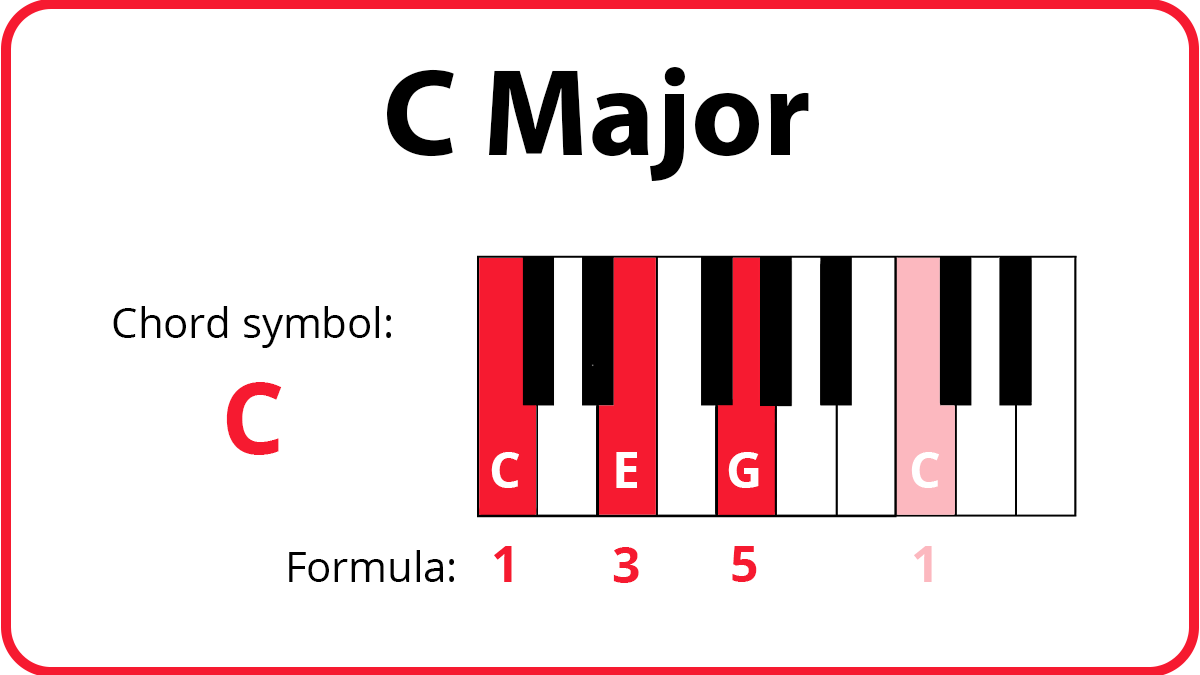
And here are all the major triads built on all twelve tones, in root position:
C
C-E-G

D
D-F#-A

E
E-G#-B

F#
F#-A#-C#

A♭
A♭-C-E♭

B♭
B♭-D-F

D♭
D♭-F-A♭

E♭
E♭-G-B♭

F
F-A-C

G
G-B-D

A
A-C#-E

B
B-D#-F#

The minor chord is a close relative of the major chord. Minor chords sound “sad” and are built on the, first, flat third, and fifth note of the major scale. We flat the third by lowering that note a half-step. In Cm, E becomes E♭. You can also look at this triad as a major third over a minor third. Here is a C minor triad:
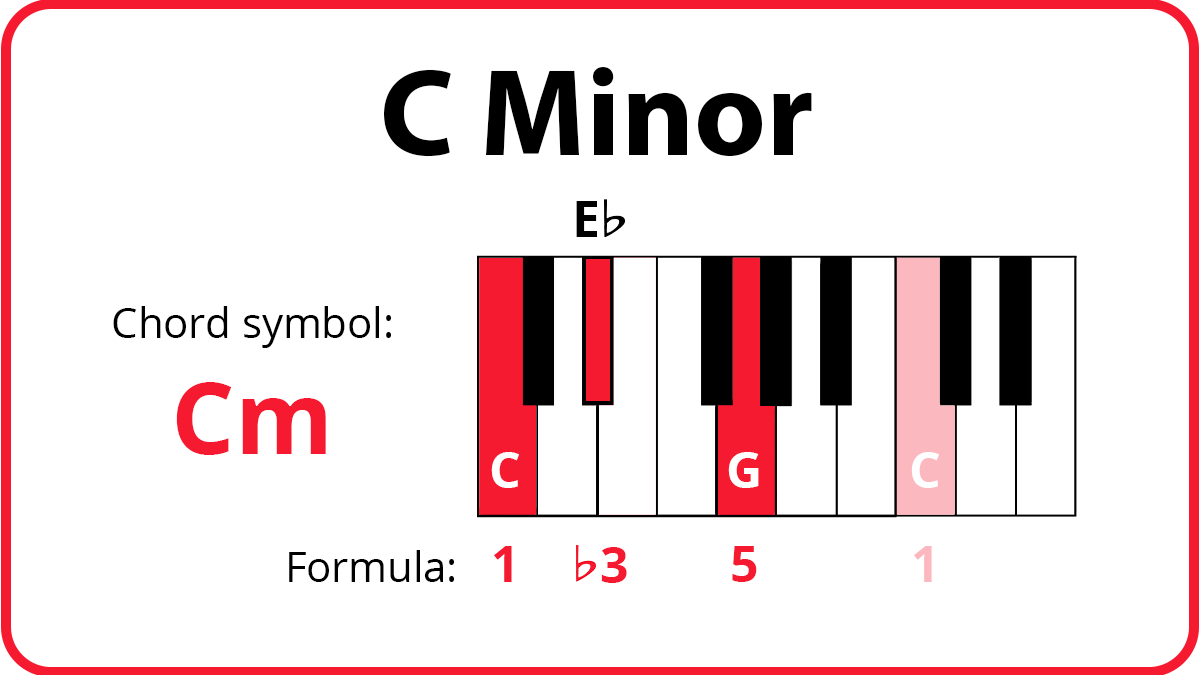
And here are all the minor triads built on all twelve tones, in root position:
Cm
C-E♭-G

Dm
D-F-A

Em
E-G-B

F#m
F#-A-C#

A♭m
A♭-C♭-E♭

B♭m
B♭-D♭-F

C#m
C#-E-G#

E♭m
E♭-G♭-B♭

Fm
F-A♭-C

Gm
G-B♭-D

Am
A-C-E

Bm
B-D-F#


If you struggle with reading music, you’re not alone! Did you know you can play hundreds of songs without standard notation? We’ll show you the secrets traditional lessons won’t teach in a 100% free webinar. It’s open to all ages and ability levels. Just show up and have fun!
You can think of diminished chords as minor chords that have been “shrunk.” Like the minor chord, the third in this chord is lowered by a half-step. The chord further “shrinks” because we also lower the fifth by a half-step. The resulting chord can sound jarring, but when used appropriately, adds a dramatic flair to a song. Here’s a C diminished triad in root position:
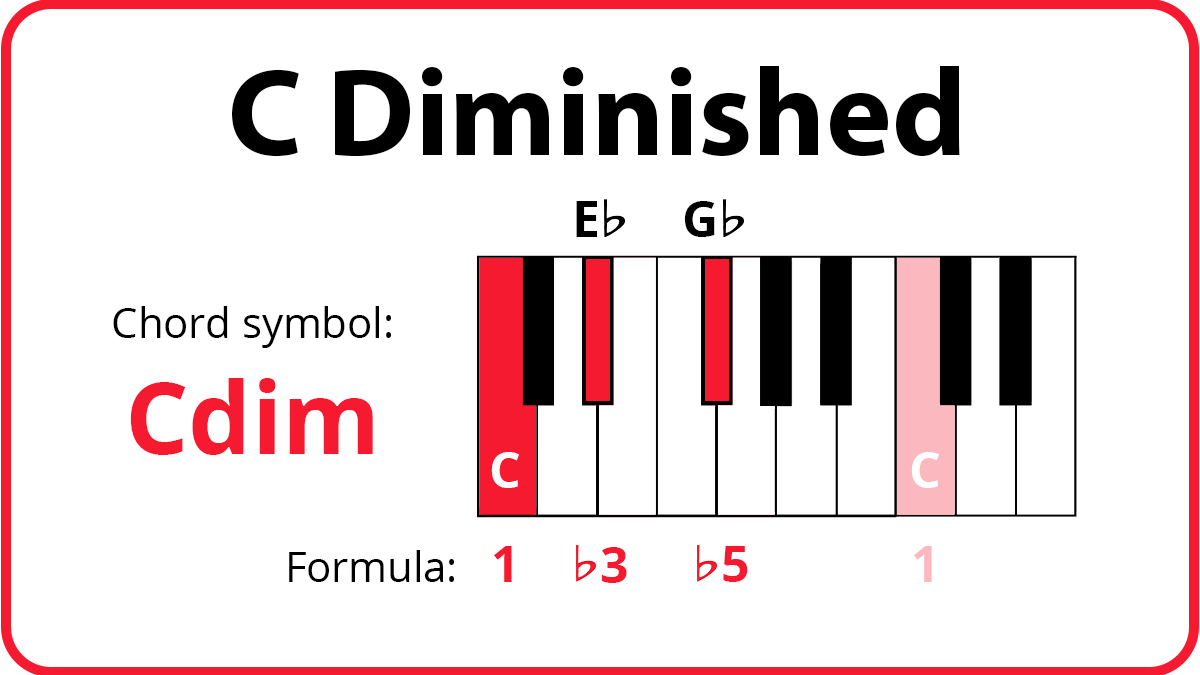
Augmented chords can be thought of as “wider” or “bigger” than a major chord. In an augmented triad, we take a major chord and raise the fifth by a half-step. Here is a C augmented triad in root position:
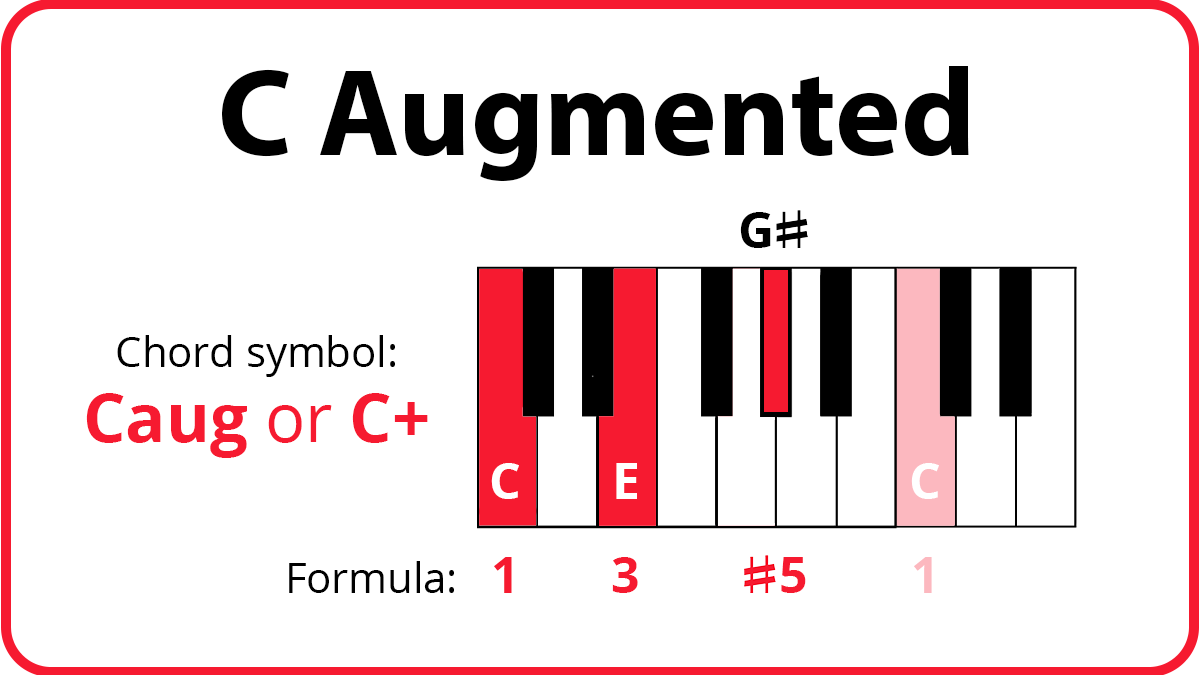
🔥 Pop Quiz!
See if you can name what notes are in these chords. Answers are at the bottom of this post.
The Piano Chords & Scales book is one of our top-selling products of all time. Now, you can get it electronically for free. That means you can instantly look up scales and chords on your phone, tablet, or laptop without hunting for WiFi. The book contains major, blues, pentatonic, and all three minor scales. Plus major, minor, and 7th chords in all inversions, and sus chords.
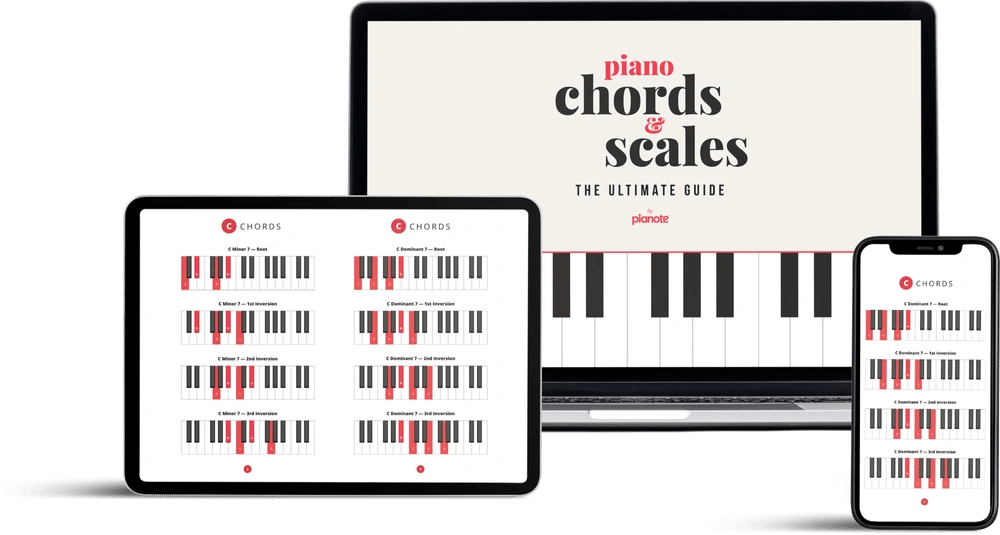
You can play a lot of good music using just triads, but seventh chords are where things get magical. Seventh chords quickly jazz up a song because they add an extra layer of depth and tension to your harmonies.
A major 7th chord is built by adding a major seventh to a major triad stack. These chords add a dreamy, jazzy feel to songs but still sound very “major.” Be careful not to mix up major 7th and dominant 7th chords—there is a difference! Here is the C major 7 chord in root position:
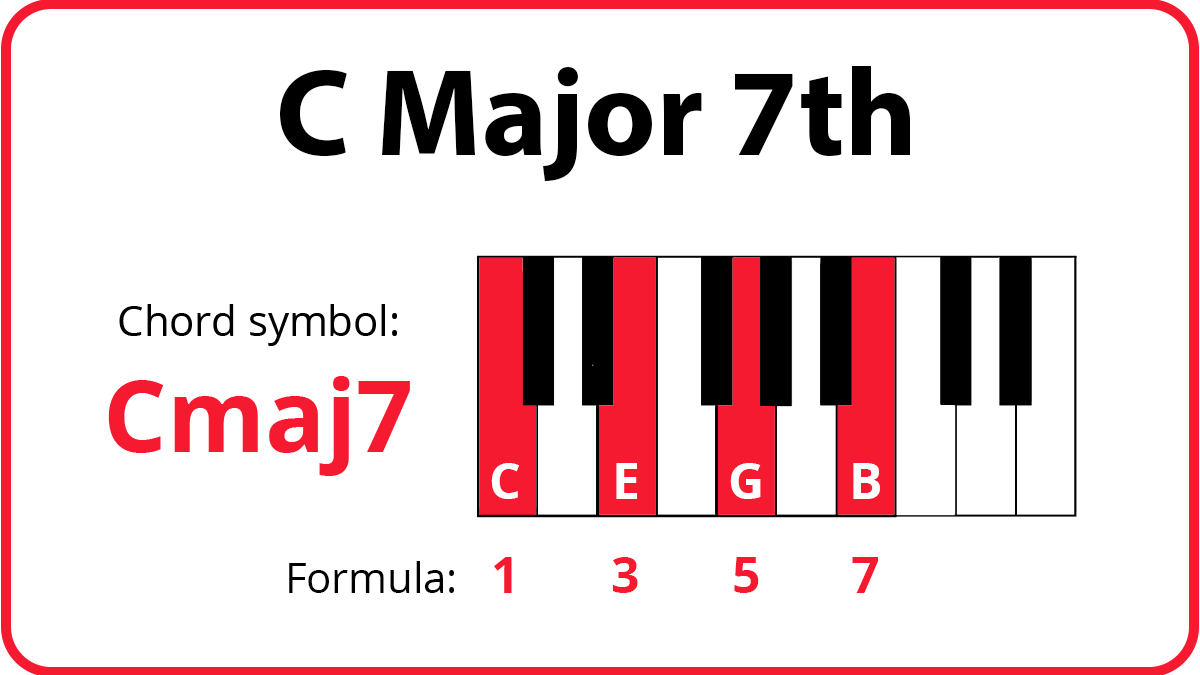
And here are all the major 7 chords built on all twelve tones, in root position:
Cmaj7
C-E-G-B

Dmaj7
D-F#-A-C#

Emaj7
E-G#-B-D#

F#maj7
F#-A#-C#-E#

A♭maj7
A♭-C-E♭-G

B♭maj7
B♭-D-F-A

D♭maj7
D♭-F-A♭-C

E♭maj7
E♭-G-B♭-D

Fmaj7
F-A-C-E

Gmaj7
G-B-D-F#

Amaj7
A-C#-E-G#

Bmaj7
B-D#-F#-A#

Dominant 7th chords have a flattened seventh note. This is because this chord takes the key signature of the note a perfect fifth down from the root. “Dominant” in music means “fifth.” Think of the chord’s root note (C) as the fifth note of a scale. Count down a perfect fifth, and you’ll land on F. The F major scale has one flat (B). Therefore, C7 is the dominant 7th chord of F major and comprises C, E, G, and B♭. Here is the C dominant 7th chord in root position:
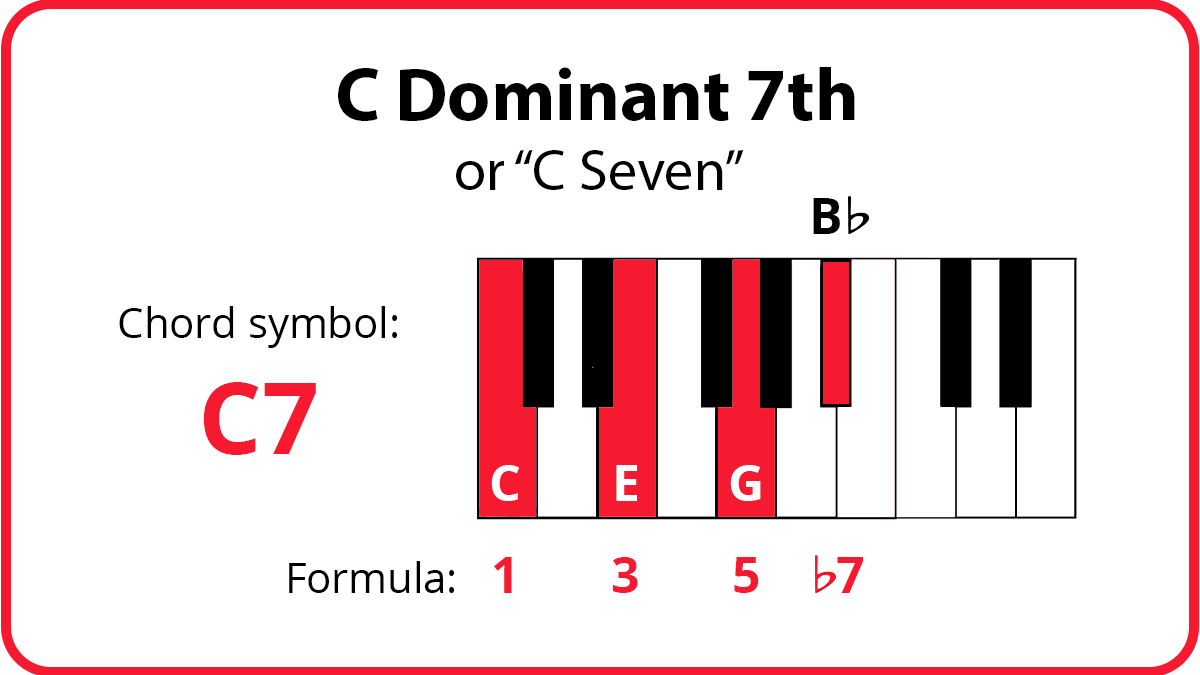
And here are all the dominant 7th chords built on all twelve tones, in root position:
C7
C-E-G-B♭

D7
D-F#-A-C

E7
E-G#-B-D

F#7
F#-A#-C#-E

A♭7
A♭-C-E♭-G♭

B♭7
B♭-D-F-A♭

D♭maj7
D♭-F-A♭-C♭

E♭7
E♭-G-B♭-D♭

F7
F-A-C-E♭

G7
G-B-D-F

A7
A-C#-E-G

B7
B-D#-F#-A

To create a minor 7th chord, take a minor triad (1-♭3-5) and add a minor seventh interval. If C is your root, your chord would be C-E♭-G-B♭.
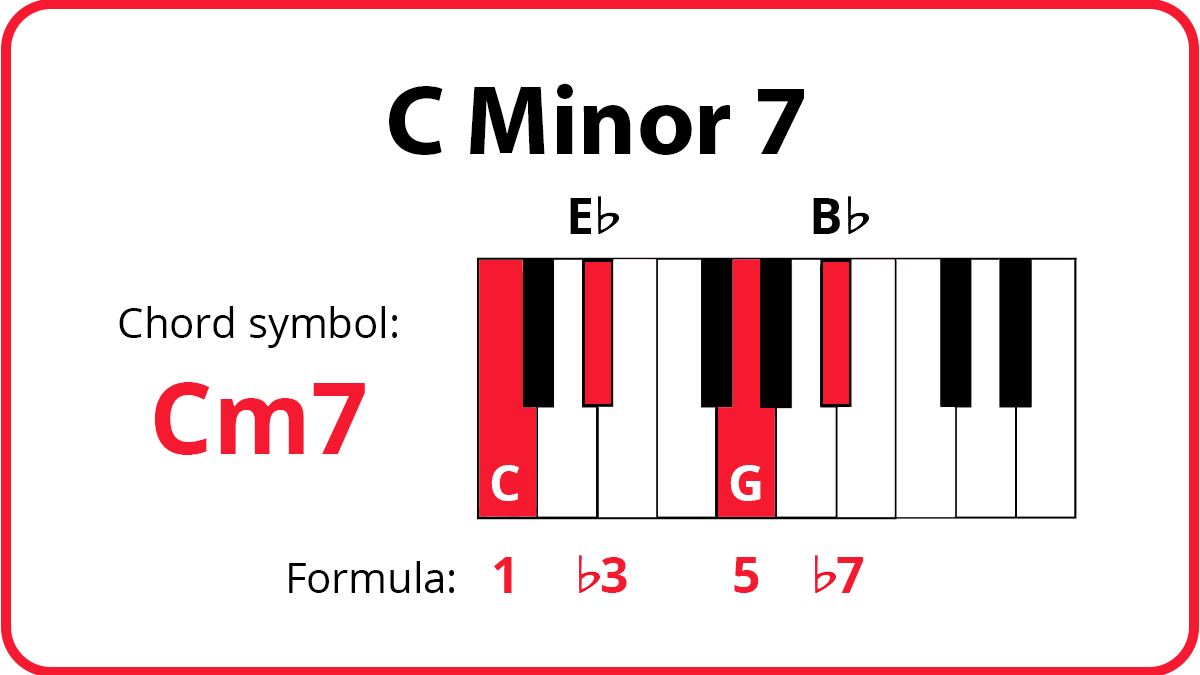
And here are all the minor 7 chords built on all twelve tones, in root position:
Cm7
C-E♭-G-B♭

Dm7
D-F-A-C

Em7
E-G-B-D

F#m7
F#-A-C#-E

A♭m7
A♭-C♭-E♭-G♭

B♭m7
B♭-D♭-F-A♭

C#m7
C#-E-G#-B

E♭m7
E♭-G♭-B♭-D♭

Fm7
F-A♭-C-E♭

Gm7
G-B♭-D-F

Am7
A-C-E-G

Bm7
B-D-F#-A

Diminished 7th chords have a dramatic, “villainous” sound. While they may sound jarring on their own, appropriately used diminished 7th chords can add a powerful emotional punch to songs.
You can think of diminished 7th chords as a stack of minor 3rds. We double-flat the seventh, which makes the top note in Cdim7 equivalent to A. Learn more about diminished chords here. Here is the Cdim7 in root position:
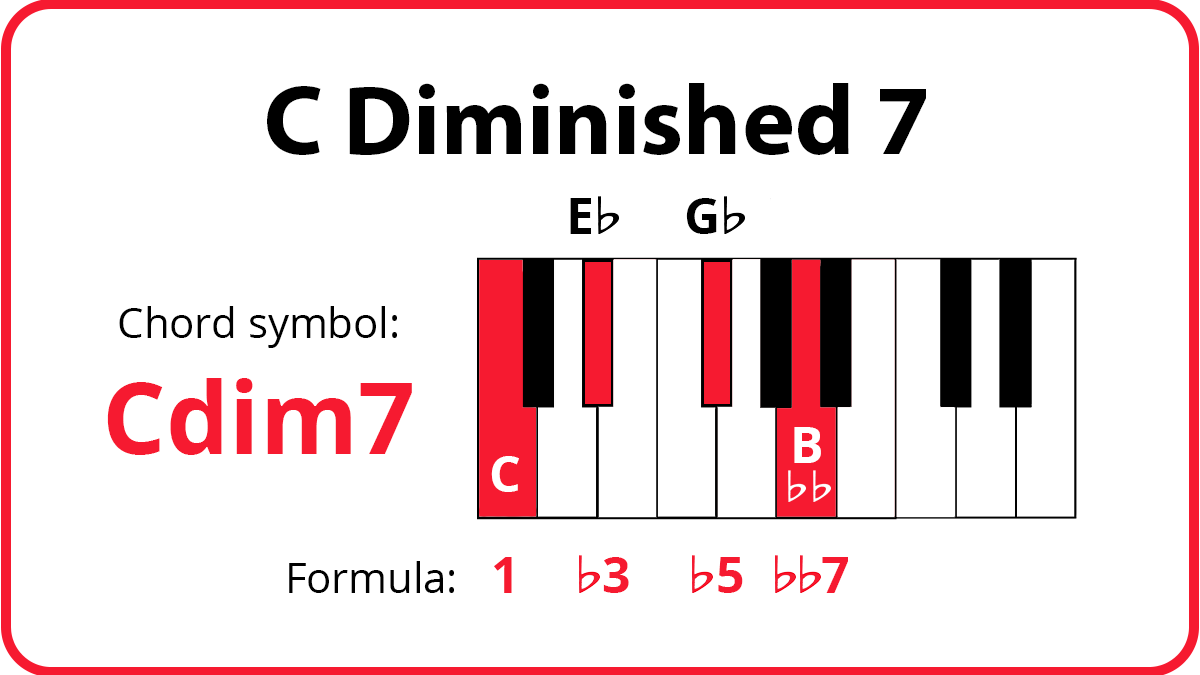
And here are all the diminished 7 chords built on all twelve tones, in root position:
Cdim7
C-E♭-G♭-B♭♭

Ddim7
D-F-A♭-C♭

Edim7
E-G-B♭-D♭

F#dim7
F#-A-C-E♭

A♭dim7
A♭-C♭-E♭♭-G♭♭

B♭dim7
B♭-D♭-F♭-A♭♭

C#dim7
C#-E-G-B♭

E♭dim7
E♭-G♭-B♭♭-D♭♭

Fdim7
F-A♭-C♭-E♭♭

Gdim7
G-B♭-D♭-F♭

Adim7
A-C-E♭-G♭

Bdim7
B-D-F-A♭

The half-diminished or “flat-five” chord strikes fear in many musicians because it looks super complicated, but it really isn’t! The instructions are in the name: just take a normal Cm7 chord and lower the fifth by a half-step. Here is a diagram of Cm7♭5.
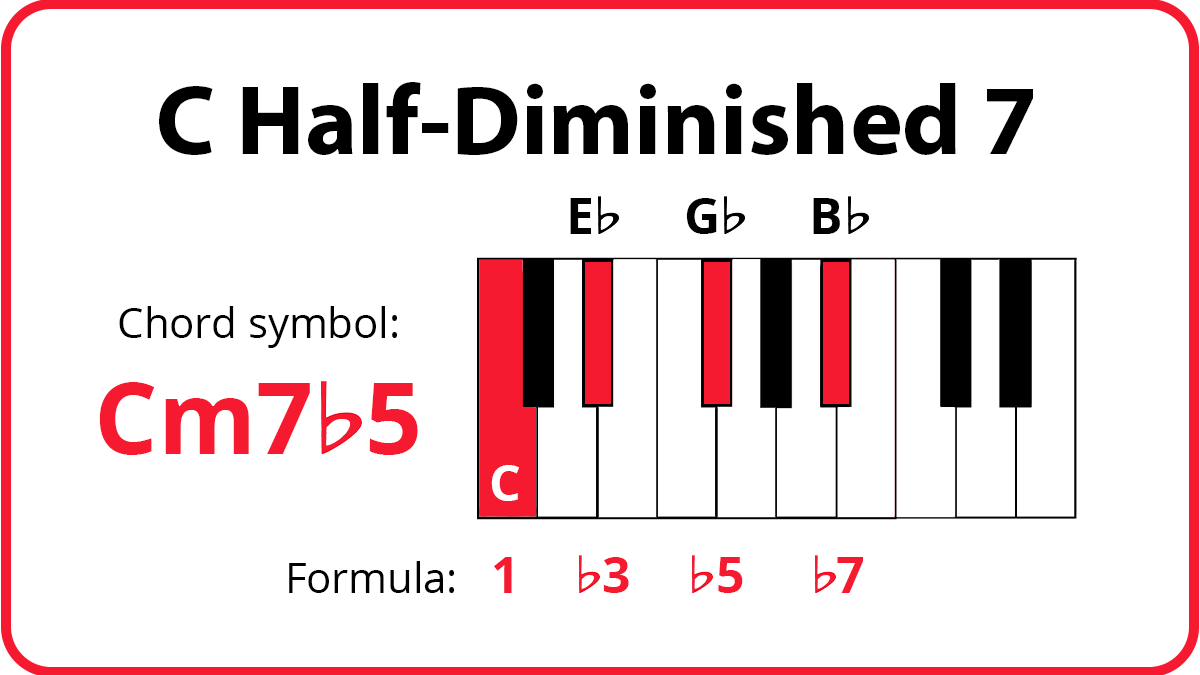
And here are all the half-diminished 7 chords built on all twelve tones, in root position:
Cm7♭5
C-E♭-G♭-B♭

Dm7♭5
D-F-A♭-C

Em7♭5
E-G-B♭-D

F#m7♭5
F#-A-C-E

A♭m7♭5
A♭-C♭-E♭♭-G♭

B♭m7♭5
B♭-D♭-F♭-A♭

C#m7♭5
C#-E-G-B

E♭m7♭5
E♭-G♭-B♭♭-D♭

Fm7♭5
F-A♭-C♭-E♭

Gm7♭5
G-B♭-D♭-F

Am7♭5
A-C-E♭-G

Bm7♭5
B-D-F-A

In genres like jazz, you may find funny-looking chords like C9 or even Cmaj13! These are called chord extensions. Chord extensions refer to chords that have notes beyond the octave.
Basically, we keep stacking notes on top of a seventh chord to create tension. However, a key thing to remember is that numbers greater than 7 are, by default, major intervals from the root. So, a Cm13 chord has an A, not an A♭ (as it would if we were to use the C Minor key signature), because a major ninth from C is A.
Here are examples of chord extensions with the extended part in pink:
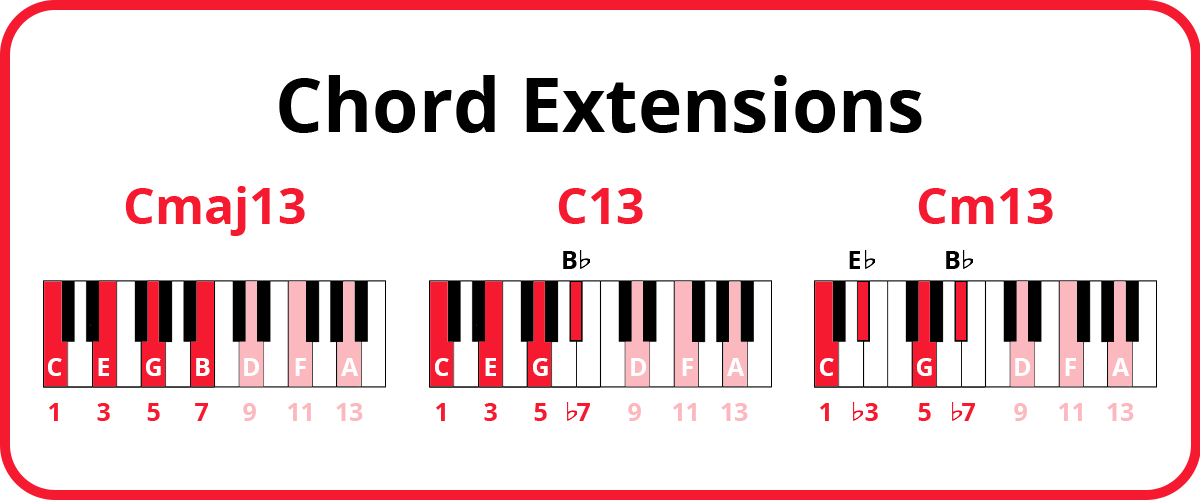
Important: You do not have to play these chords with one hand! Most pianists will split these chords across two hands. And many pianists will even omit some notes, as sometimes too many notes can create dissonance. So, experiment with omitting different notes.
🔥 Pop Quiz!
What are the notes in the following chords? Answers are at the bottom of this post.
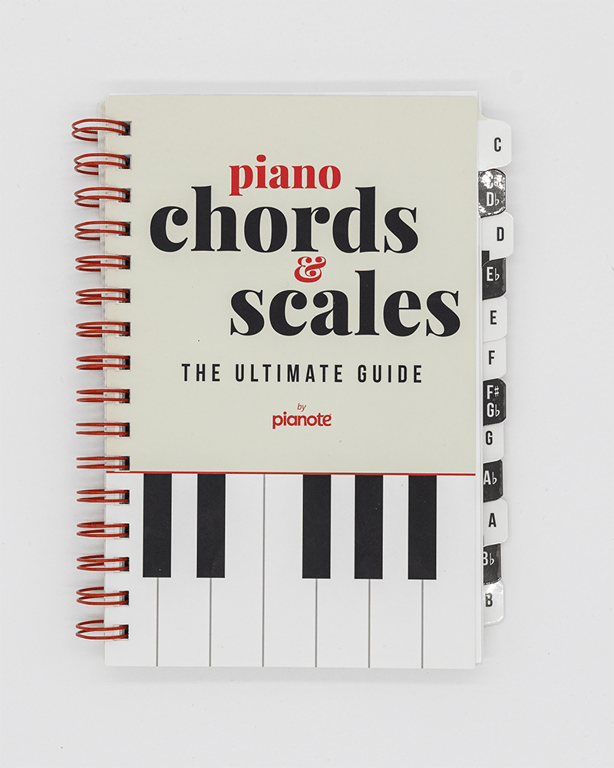
The Piano Chords & Scales book is your new best friend. This beautiful, coil-bound reference guide lists chords, major scales, the three minor scales, and even pentatonic and blues scales. No more Googling chords—just flip to the key you need with the handy tabs! Learn more about the book here or join hundreds of piano players around the world and grab your copy today.
As you go along your piano chording journey, you’ll meet more interesting chord symbols and musical words that describe the context of a chord or what’s been altered. Here are some other common types of chords.
See: Diatonic Chords, Explained
Diatonic chords refer to all the chords that naturally occur on a certain scale. These chords align with the scale’s key signature. For example, here are the diatonic chords of C Major:
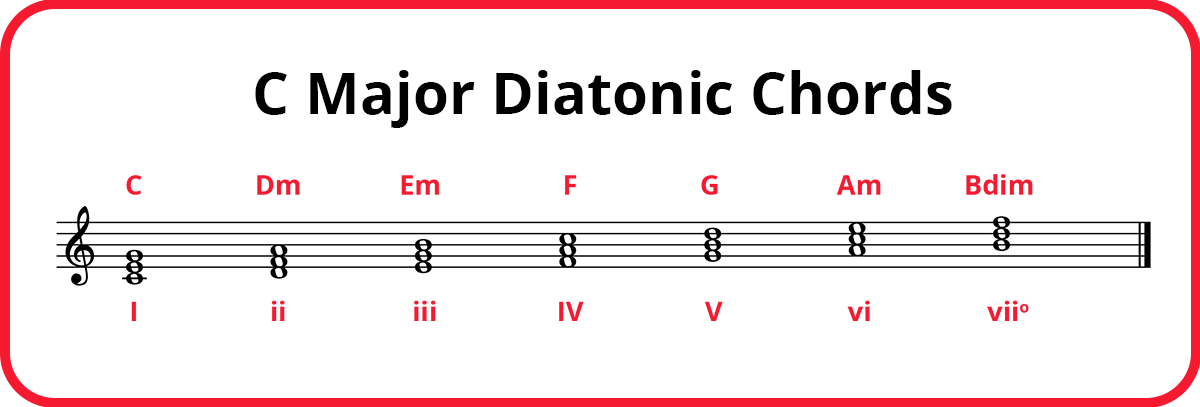
Interestingly, the pattern of chord types here is the same across all major keys. A ii chord in F Major will also be minor.
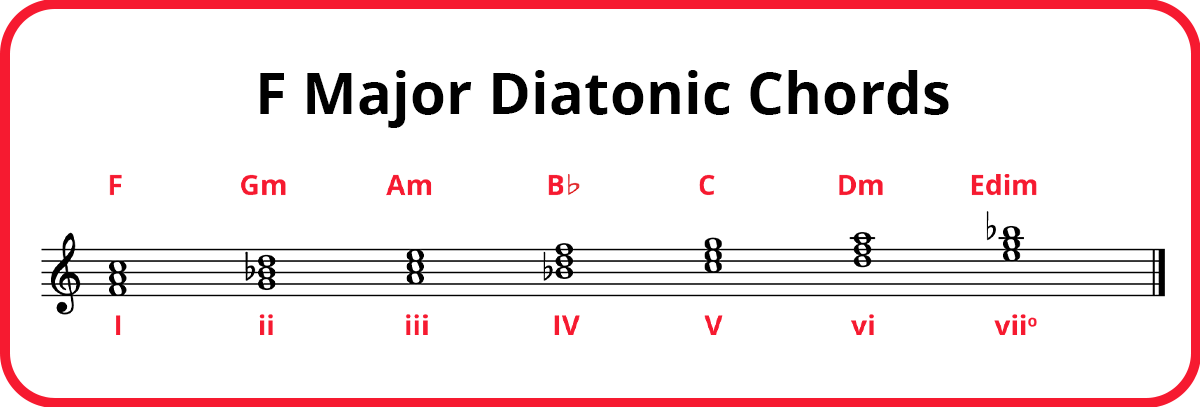
Slash chords look like a combination of a chord symbol and a single note. When you see a symbol like this, play the note to the right of the slash with your left hand as a bass note. Then, play the chord to the left of the slash with your right hand. You can think of this chord symbol as saying “play C over E.”
C/E is essentially a C chord in first inversion. Slash chords are how we notate inverted chords in a chord chart.
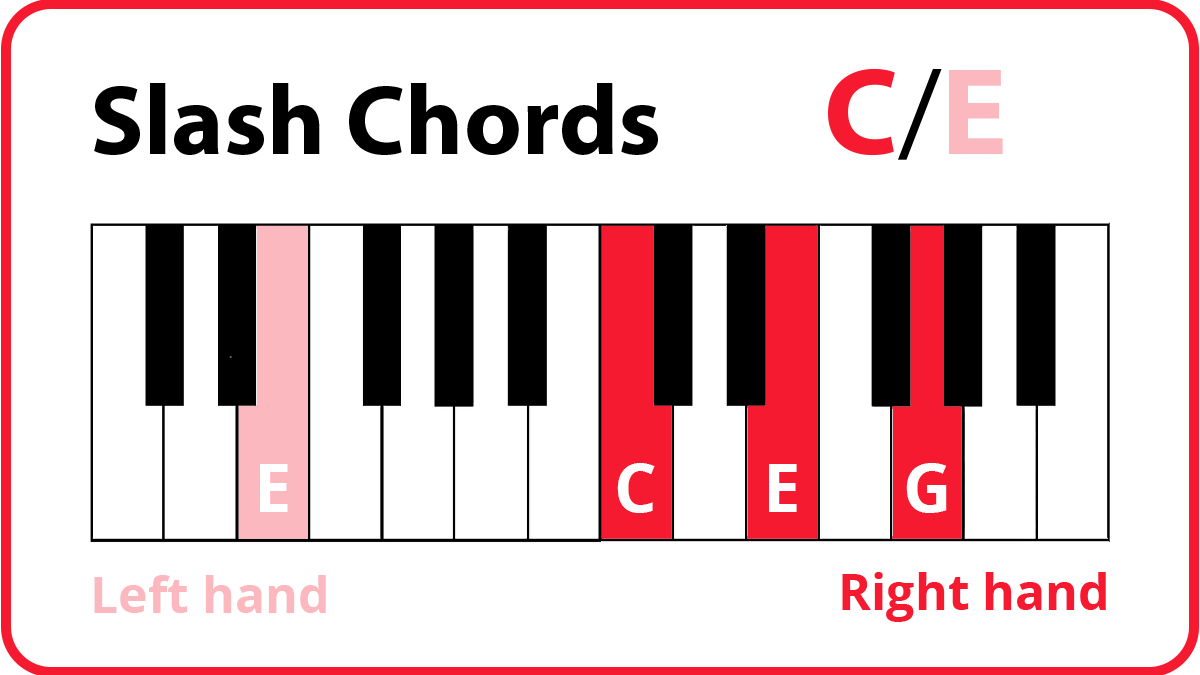
In this case, “sus” means “suspended.” Sus chords are when we suspend a middle tone and replace it with another.
In a sus2 chord, replace the third with the second note from the root. In a sus4 chord, replace the third with the fourth note from the root.
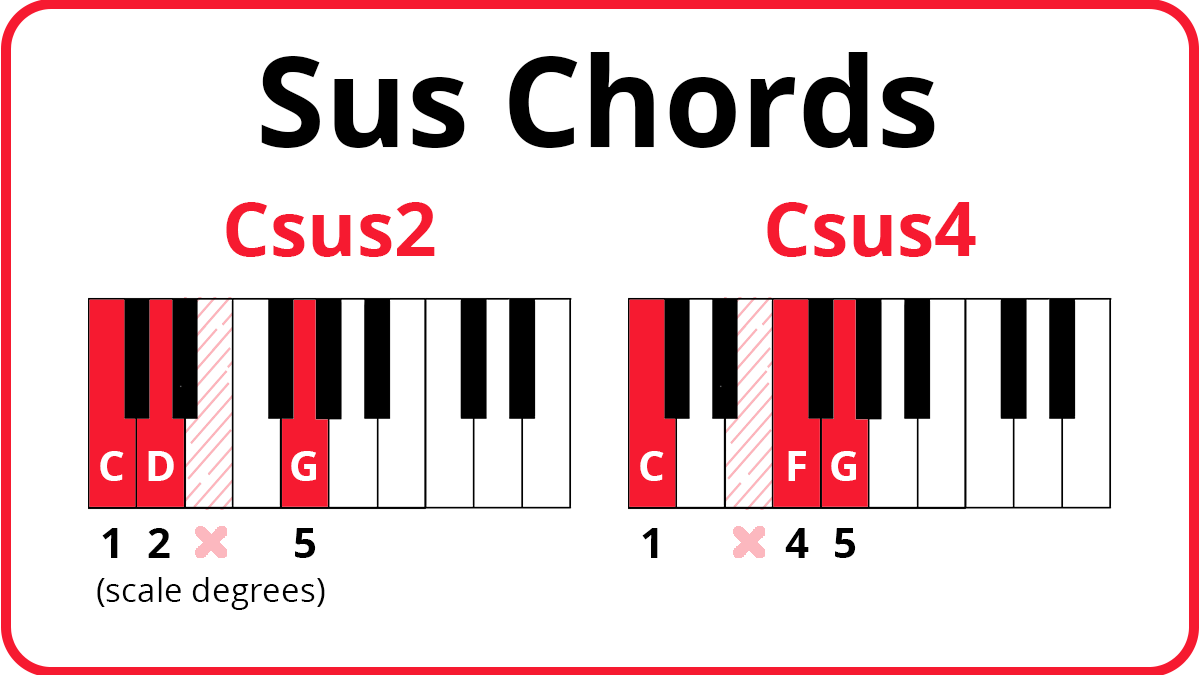
When you see “add” in a chord name, this means add an extra tone on top of your existing triad.
The difference between “Cmaj9” and “Cadd9” is that Cmaj9 includes the whole stack of thirds, while Cadd9 just means add the ninth tone to the existing C triad.
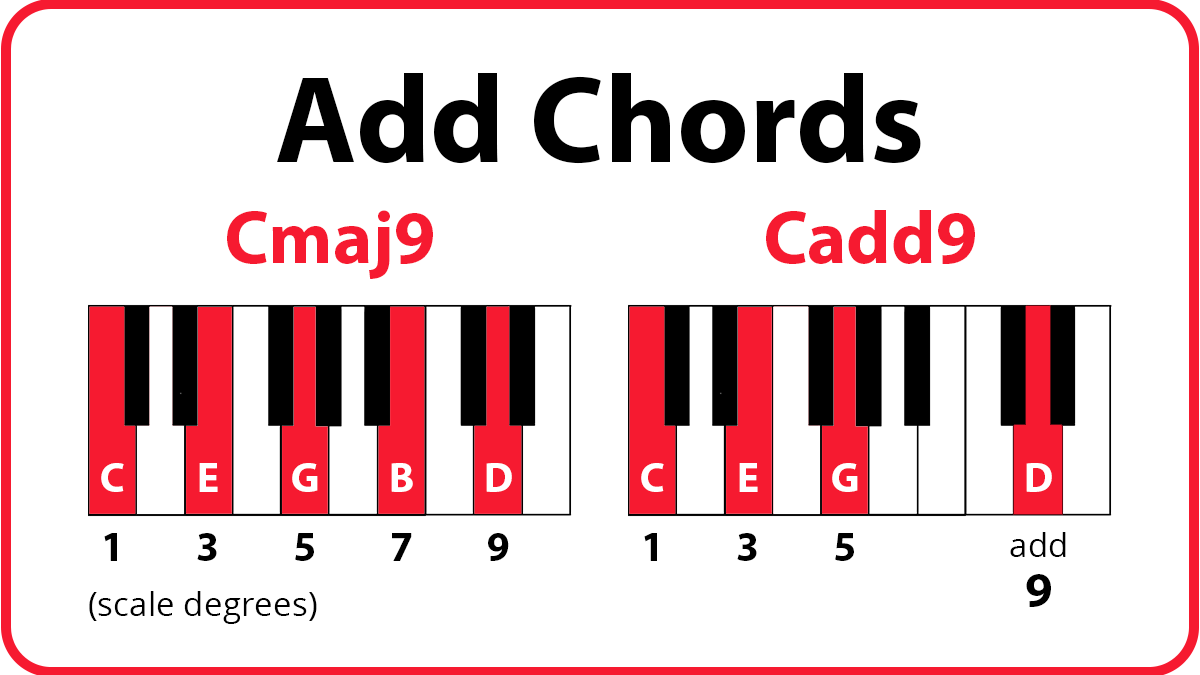
🔥 Pop Quiz!
What are the notes in these chords? Find the answers at the bottom of this post.
Don’t want to memorize formulas? Download a free chord poster of all the piano chords we discussed, in C Major. Print out and post this cheat sheet on the wall behind your piano!

Triads
7th Chords & Chord Extensions
Other Chord Types
Whew, that was a lot of chords to learn!
If you’re intimidated by the volume of chords, don’t worry, you don’t have to memorize them all at once! Print out the chord poster and hang it behind your piano. The more you make use of these chords, the more you’ll remember them.
When you’re ready to move on from C Major, work on the next key. It’s all the same formula. For example, a dominant 7th flat 5 chord in D Major is 1-3-♭5-♭7. Translated into notes, that’s D-F#-A♭-C♮.
To learn more about keys, check out our lesson on the Circle of Fifths. Happy practicing!
You’ll get access to the 10-step Pianote Method, designed for modern learners in mind. Plus: learn directly from world-class Pianote Coaches, connect live with our in-house instructors, and meet piano people just like you! Learn wherever you want, whatever you want, whenever you want.
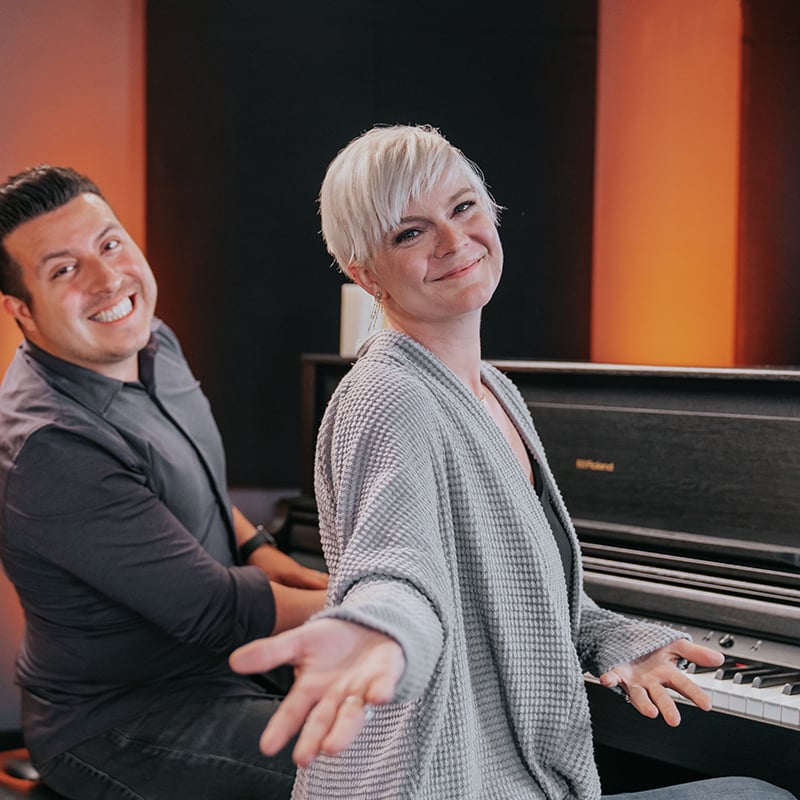
Pianote is the Ultimate Online Piano Lessons Experience™. Learn at your own pace, get expert lessons from real teachers and world-class pianists, and join a community of supportive piano players. Learn more about becoming a Member.


By signing up you’ll also receive our ongoing free lessons and special offers. Don’t worry, we value your privacy and you can unsubscribe at any time.
We use cookies for traffic data and advertising. Cookie Policy »